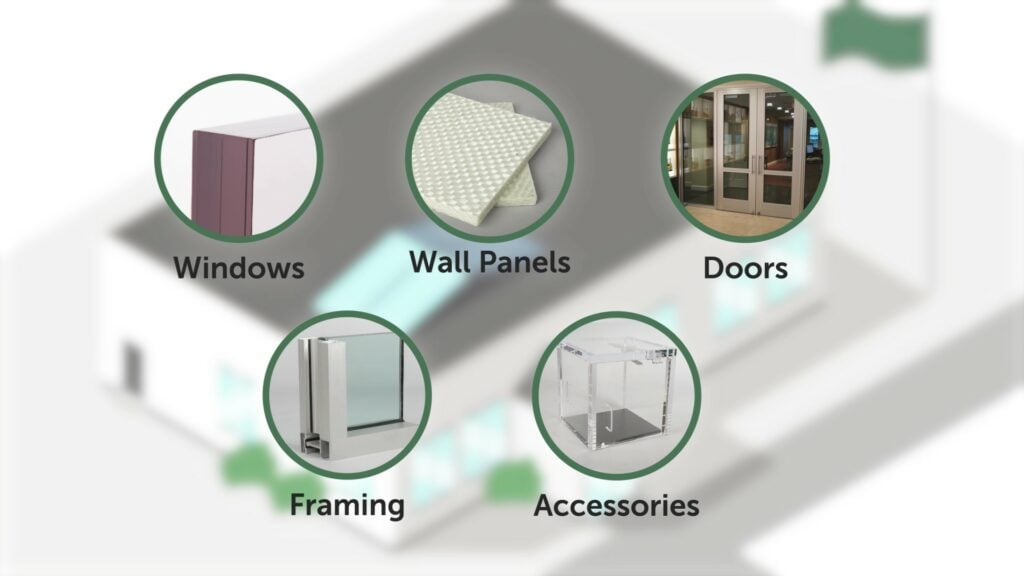For those unfamiliar with ballistic security, it would be easy to assume the process needs only to involve a singular piece of bulletproof glass. Because the name itself inspires confidence, the average person may be unaware of the various components necessary to protect their environment. If you’ve seen our video How To Stop A Bullet: A Ballistic Systems Approach, you know that here at TSS we recommend a full “Systems Approach,” as no single ballistic item can provide adequate protection on its own. A cohesive system is needed to protect your people and property and can be achieved using various bulletproof products.
Bulletproof Components
In order to have a truly effective bulletproof system, you need to consider the major contributing components–these are the aspects essential to any successful physical security solution. The major components of a ballistics system are:
- Windows
- Wall Panels
- Doors
- Framing
- Accessories
One of the things that makes TSS unique is our approach to ballistic security. We consult with each customer to determine what solution best meets their needs, providing a custom-designed solution and even sometimes helping with installation. Instead of selling parts or prefabricated components, we provide ballistic solutions to fit your unique space. As our CEO Jim Richards says: "We specialize in assessing each project on an individual basis, so our solutions are truly customized to meet the task at hand; our work is all about finding the right solution for each unique situation."
What A Bulletproof System Looks Like
We’ve talked about how an individual component isn’t enough to provide adequate defense, but what does this protection look like? If you’re looking to keep your building and those in it safe and secure, what measures must be taken? Let’s take a look at some specific components and how they might come together to build something greater.
Exterior
Imagine, if you will, a municipal building. Your local government takes ballistic security seriously because they understand the importance of protecting their facilities, and they want to be sure they’ve invested their time and money in the right places. They begin with the outside of the building. In this example, the ground floor windows use Ballistic Glass of a Level appropriate to the security risk (click here for our infographic on The 8 Levels of Bullet-Resistant Security Glass and the amount of protection afforded by each level).
Entryway and Vestibule
Next, we move on to the main entry and vestibule. It is common practice to use a Level 3 Aluminum with a Glass Panel Door for the exterior door, but that alone isn’t enough. Secure doors require matching surrounding glass panels, frames, and hardware, such as Level 3 Ballistic Framing, in order to be fully effective. When considering the vestibule door, options include matching the exterior door with the same set-up or reflecting the design of the lobby interior.
Lobby
Upon moving through the vestibule, visitors will likely spot a security booth or help desk. In this municipal example, we recommend using Level 3 Ballistic Fiberglass Panels packed into the booth walls, as well as low-rise Ballistic Glass panes of a matching ballistic level on top of those walls, giving a clear line of visibility and providing easier interactions with the public.
Depending on their reason for coming in, visitors would then likely stop at either the treasurer’s window or the clerk’s counter. This particular building has kick panels, counters, and glass at both locations with a Level 3 rating. The treasurer’s window features a Recessed Deal Tray to allow payments to pass under the window without compromising the staff’s safety. Oftentimes, a Speak Hole & Backer talk-through will also be included to maximize vocal clarity while still protecting employees.
The clerk’s counter will have a different set of needs and may incorporate a package passer (in the form of Window Cutouts, Interlocking Package Passers, Transaction Drawers, or Horizontal Sliding Transaction Windows) to accommodate the receiving of packages. This counter may also see a variety of options for voice communication, including Arched Transaction Windows, Voice Around Windows, and Baffle Interior Transaction Windows.
Executive and Back Offices
So far, we’ve examined the exterior and immediate interior of the building, but what about back offices and workstations? In this example, executive offices are outfitted with Level 3 or 4 wooden doors built with a Bullet-Resistant Fiberglass Core and matching glass panes and framing. Surrounding walls are packed with Ballistic Fiberglass, and the executive office’s windows are Level 3 Ballistic Glass.
Since it’s impractical to protect individual employee workstations, safe spaces can be created for a large number of staff during an attack. This is typically done by utilizing conference rooms constructed or retrofitted with ballistic protection similar to the executive office. These “safe rooms” can help create a secure location for employees to gather in the event of a security incident.
Next Steps
After looking at the example system outlined above, it should be evident why custom security solutions play such a critical role in workplace protection. Now that you’ve seen the big picture, we invite you to explore some of our other resources such as our checklist 10 Things That Will Make or Break Your Bullet-Resistant Barrier Project.
Our ballistics experts are always available to answer any questions, and they look forward to discussing how different bulletproof products come together in a cohesive ballistic system.

